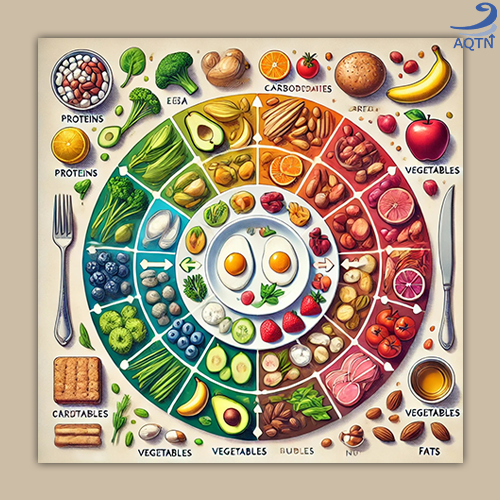
The Art of Food Combining: A Naturopathic Perspective
Food combining, also known as “combinaisons alimentaires” in French, is an approach to eating based on the principle that certain foods and macronutrients digest better when paired together, while others might hinder digestion when consumed in combination. Popularized by naturopaths, this practice is said to improve nutrient absorption, reduce bloating, and enhance overall vitality.
In this article, we will explore food combining from a naturopathic point of view, examine the rationale behind it, and provide a summary table that illustrates which foods or macronutrients can be mixed and which combinations are best avoided.
The Naturopathic Rationale for Food Combining
Naturopathy views the body as an interconnected system, where digestion plays a pivotal role in overall health. According to naturopathic principles, poor digestion can lead to a range of health problems, including fatigue, bloating, indigestion, and even chronic diseases.
Food combining theory is rooted in the belief that different macronutrients (proteins, carbohydrates, and fats) require distinct enzymes for digestion, and that the body may struggle to break them down efficiently when they are consumed together.
For example:
- Proteins require an acidic environment in the stomach to be properly digested.
- Carbohydrates are digested in a more alkaline environment.
- Fats slow down the digestive process as they require bile for breakdown.
By following specific rules for combining foods, naturopaths believe digestion can be optimized, leading to better nutrient absorption, more energy, and reduced digestive discomfort.
- Proteins and Starches Should Not Be Combined : Proteins like meat, fish, eggs, and legumes require acidic gastric juices for digestion, while starchy foods such as bread, rice, potatoes, and pasta require alkaline conditions. When consumed together, it is believed the stomach’s acidity and alkalinity neutralize each other, leading to inefficient digestion and fermentation in the gut.
- Fruits Should Be Eaten Alone : Fruits, especially those that are high in sugar, pass quickly through the digestive system. If combined with other foods, particularly proteins or starches, they can ferment in the stomach, causing bloating and gas. Fruits are best consumed on an empty stomach or between meals.
- Do Not Mix Different Types of Protein : Each type of protein, such as fish, chicken, or cheese, requires specific enzymes and different amounts of time to digest. Consuming multiple types of protein together can tax the digestive system.
- Fats and Proteins Can Be Combined : While fats slow down digestion, they can combine harmoniously with proteins. The body uses bile to emulsify fats, and this process doesn’t interfere with protein digestion.
- Green, Non-Starchy Vegetables Can Be Combined with Anything : Vegetables like leafy greens, cucumbers, zucchini, and broccoli are neutral foods that can combine well with proteins, carbohydrates, and fats. Their high fiber content can even aid digestion.

Summary Table of Food Combining: What Can Be Mixed and What Cannot
| Macronutrient/Category | Can Be Combined With | Avoid Combining With |
| Proteins (meat, eggs, legumes) |
Fats, Non-starchy Vegetables | Starches (bread, potatoes), Fruits |
| Starches (rice, pasta, bread) |
Non-starchy Vegetables | Proteins, Fats, Fruits |
| Fats (oils, butter, avocado) |
Proteins, Non-starchy Vegetables | Starches, Fruits |
| Fruits (especially sweet fruits) |
Alone, Between meals | Proteins, Starches, Fats |
| Non-Starchy Vegetables (leafy greens, zucchini) |
Proteins, Starches, Fats, Fruits | None |
| Dairy Products (milk, cheese) |
Best consumed alone | Proteins, Starches |
Examples of Meals with Proper Food Combining
To give you a better sense of how to apply food combining principles in daily life, here are a few meal suggestions:
- Breakfast: A bowl of mixed fresh fruit (eaten on an empty stomach).
- Lunch: A green salad with olive oil, avocado, and grilled chicken breast (protein + fat + non-starchy vegetables).
- Dinner: Brown rice with steamed vegetables like broccoli, zucchini, and a side of avocado (starch + non-starchy vegetables + fat).
The scientific community generally does not support food combining as strongly as naturopathy. The body is equipped with the ability to digest mixed meals containing proteins, fats, and carbohydrates simultaneously.
Various enzymes are secreted in different regions of the digestive tract to ensure that macronutrients are broken down effectively. Additionally, there’s no conclusive evidence that separating food groups improves digestion or prevents fermentation in the stomach.
However, some proponents argue that while the body can technically handle mixed meals, simplifying the process might allow it to work more efficiently. For individuals with specific digestive issues like irritable bowel syndrome (IBS) or chronic bloating, following food combining principles could offer relief, as it encourages mindful eating and avoiding highly processed foods.

Conclusion
Food combining, from a naturopathic perspective, offers a mindful approach to eating that emphasizes the body’s natural digestive rhythms. While it may not be supported by mainstream science, many people experience improved digestion, more energy, and fewer digestive problems when following these guidelines.
Ultimately, food combining is not a strict dietary rule but rather a tool that can help you tune into your body’s needs. If you feel sluggish or bloated after certain meals, experimenting with different food combinations may be worth exploring.
By respecting the body’s digestive processes, naturopathy encourages us to eat in harmony with our physiology, optimizing our health and well-being.

